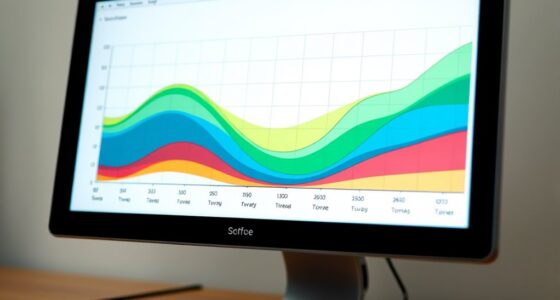A risk matrix helps you evaluate hazards by plotting their likelihood against potential impact, making it easier to prioritize issues that could cause the most harm. You assign scores based on how often a risk may occur and how severe its consequences could be. This visual tool guides you to focus on high-priority risks first and allocate resources efficiently. Keep exploring to see how this approach improves your overall risk management process.
Key Takeaways
- The risk matrix plots risks based on their likelihood of occurrence and potential impact severity.
- Likelihood refers to how probable a hazard is to happen, while impact assesses the potential damage caused.
- Combining these factors helps prioritize risks by identifying which are most critical to address.
- The matrix’s grid format visually categorizes risks as low, medium, or high priority.
- This visualization supports informed decision-making and targeted resource allocation for risk mitigation.

A risk matrix is a practical tool that helps you evaluate and prioritize potential hazards by appraising their likelihood and impact. When you conduct a risk assessment, you systematically identify hazards that could threaten your project, workplace, or process. Hazard identification is the first critical step; it involves recognizing what could go wrong and understanding the sources of these risks. Once you’ve identified these hazards, the risk matrix allows you to visualize and analyze them effectively.
Using a risk matrix, you assign each hazard a score based on its probability of occurrence and the severity of its consequences. This approach simplifies complex data and makes it easier to compare different risks side by side. For example, if a hazard has a high likelihood of happening and could cause severe damage or harm, it will be rated as a high-priority risk. Conversely, a hazard with a low chance of occurring and minimal impact can be deprioritized. This prioritization helps you focus your resources and mitigation efforts on the most significant threats first.
The process of hazard identification feeds directly into the risk assessment, providing the raw data needed to populate the matrix. As you analyze each hazard, you consider factors like historical data, environmental conditions, and operational procedures that influence its likelihood and impact. This thorough approach ensures you don’t overlook subtle risks that could escalate later. By systematically evaluating risks, you gain clarity on where to implement controls or preventative measures, ultimately reducing the potential for accidents or failures.
The visual nature of a risk matrix makes it an invaluable communication tool across teams and stakeholders. When you present the risks in a clear, grid-like format, everyone understands which hazards require immediate attention and which ones can be monitored over time. This shared understanding enhances your risk management strategy and promotes proactive decision-making. It also encourages ongoing hazard identification, as new risks can be quickly added and re-evaluated within the matrix.
In essence, a risk matrix transforms your risk assessment process into a straightforward, strategic activity. It ensures that hazard identification leads to meaningful insights, enabling you to proactively address potential issues before they escalate. By focusing on likelihood and impact, you’re better equipped to allocate resources efficiently, mitigate risks effectively, and maintain a safer environment overall. This approach keeps your risk management organized, transparent, and responsive to evolving challenges.
Furthermore, understanding the importance of projector technology can help you better assess and mitigate risks related to equipment failures or malfunctions in your setup.
Frequently Asked Questions
How Often Should a Risk Matrix Be Reviewed and Updated?
You should review and update your risk assessment’s risk matrix at least annually, or whenever significant changes occur in your operations, environment, or regulations. Regular updates guarantee your risk assessment remains accurate and relevant. Keep an eye on emerging risks and adjust the update frequency if your risk landscape shifts rapidly. This proactive approach helps you identify potential issues early and maintain effective risk management.
What Are Common Mistakes When Creating a Risk Matrix?
When creating a risk matrix, you often overlook precise risk assessment and clear risk visualization. You might assign incorrect likelihood or impact levels, causing the matrix to misrepresent actual risks. Avoid vague categories and guarantee consistent criteria. Also, don’t forget to involve relevant stakeholders for thorough insights. These mistakes can lead to poor decision-making and ineffective risk management, so double-check your data and keep the matrix updated regularly.
Can a Risk Matrix Be Used for Qualitative and Quantitative Analysis?
Yes, a risk matrix can be used for both qualitative and quantitative analysis. You can categorize risks with descriptive data for qualitative assessment or assign numerical values for quantitative analysis. This dual approach enhances your risk assessment, empowering effective decision-making. By blending both methods, you create an all-encompassing view, helping you prioritize risks and plan appropriate responses with confidence and clarity.
How Do You Prioritize Risks Based on the Matrix?
You prioritize risks by analyzing their positions on the matrix, focusing on those with high likelihood and high impact. Use the matrix during your risk assessment to identify which risks need urgent attention and allocate resources accordingly. This method helps you make informed decisions, ensuring you address the most critical risks first. By systematically evaluating risks, you improve your decision making and effectively manage potential threats.
What Software Tools Assist in Developing Risk Matrices?
Did you know that over 60% of organizations use software tools for risk assessment? You can leverage platforms like RiskWatch, LogicManager, or @RISK to develop effective risk matrices. These tools help you visualize risks clearly, prioritize them efficiently, and improve decision-making. By integrating risk visualization features, you get a better understanding of potential impacts and likelihoods, making your risk management process more streamlined and accurate.
Conclusion
So, next time you carefully plot your risks on that fancy matrix, remember—highlighting likelihood and impact might just make you feel more in control. But ironically, the more you rely on it, the more you realize some risks are unpredictable, no matter how neatly you categorize them. Think of the matrix as your risk’s best friend… until it surprises you anyway. After all, in risk management, a little irony keeps things interesting.








